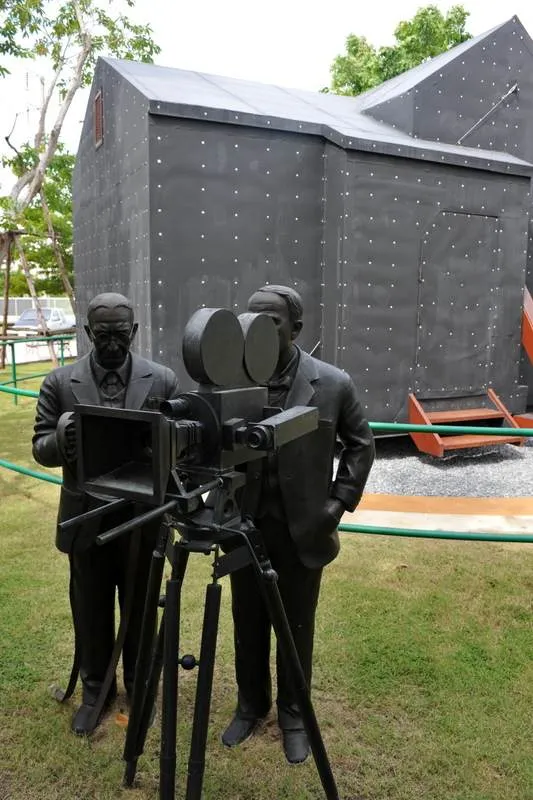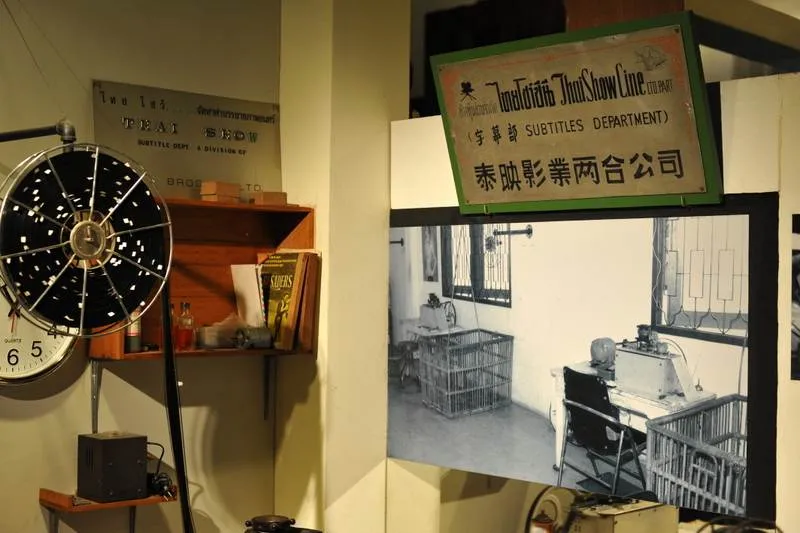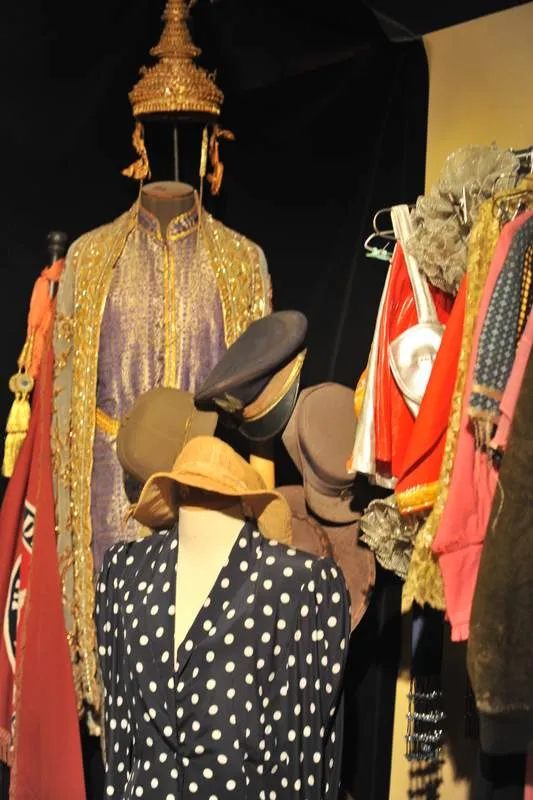
Just across Bangkok’s western border is a surprise – presenting the Thai Film Museum (พิพิธภัณฑ์ภาพยนตร์ไทย), complete with free admission and a guided tour to help you learn about Thai’s film industry.
While the museum dates back to 1984 as part of the National Film Archive, you’ll first run into a spirit theater. While most buildings in Thailand offer a spirit house to the displaced spirits, the theater also serves as a model for a long-gone historic theater – Sala Chalermthai. The theatre officially opened in 1949, delayed by war and changes in the political scene, presenting stage plays for years before converting to a cinema. In 1987 the theater was purchased by the government, then torn down in 1989 to uncover a monastery and install a memorial statue to King Rama III.

Behind the scenes of His Sweet Melody – a ‘super musical’ produced in 1937.
You may have a fair amount of time to enjoy the outdoor exhibits – the museum can only be toured with a guide, which start at 10am, 1pm, and 3pm. Thankfully, the statues and monuments outside need little guidance, since they all come with English-language signs. If you go, it’s recommended you call ahead to ensure an English-language guide can be available.
One of the first sites you’ll see on the tour is the yellow building itself, seen in the first picture. It’s a replica of a sound studio opened in 1935 along what’s now called Sukhumvit soi 21 (Asoke Montri). The studio produced 3-4 feature-length films every year, and was considered the Hollywood of Siam. After World War II, the studio became a cinema, which closed in 1965. Today, the real estate is used as a parking lot near Sukhumvit MRT station.

If you’re a film buff, you may know the black building above as the Black Maria – a movie studio created by Thomas Edison in 1893. The entire ‘house’ rotates so as to let the sun in throughout the day.
Heading in, there’s plenty more to see. It’s here where the guide kicks in, and you’ll be listening a lot closer because the English signs are no more:

Old school Thai horror, anyone? Not pictured here are some of the grisly props used some decades ago.

Before there were movies, there was shadow play – while not much time is spent looking at the precursors to film, it’s recognized nonetheless. It was 1894 when HM King Chulalongkorn (now referred to as King Rama V) visited Europe, which was documented on film and shown once he was back in Thailand. A few years later, Prince Thongthaem Sambassatra (the King’s half-brother) became the father of Thai cinema when he arranged to import the state-of-the-art camera equipment of the time. For that reason, he’s the man enshrined outside the museum.


While much of the technology originates from outside the country, that didn’t stop the Thais from making it work.

As you’d expect, a fair number of the exhibitions have taken a turn for the worse over the decades. The country’s first feature-length film, a silent film produced in 1927, has very little material that has survived to this day.

A highlight of the museum: Rattana Pestonji (1908-1970), arguably the father of contemporary Thai film. Born in Bangkok, he was one of the first Thai directors to use 35mm film over 16mm (since 35mm film enables sound to be recorded at the same time as the video, where 16mm film had to have audio dubbed-in later). While not prolific with his moviemaking, the museum houses a partial replica of the Country Hotel set. After sweeping the 1954 Asia Pacific Film Festival in Tokyo awards for the drama Santi-Weena, he was rewarded with a heavy tax on his prize money – and a fine for failing to clear the film with the Thai censors. He died in 1970, while giving a speech to filmmakers and government officials, calling on them to support the film industry.

Enter a backroom to see some of the behind the scenes action.

Animations, while not particularly something Thai is known for, can thank Payut Ngaokrachang (1929-2010) for his work in bringing animation to the country. He’s known for one full-length film, The Adventure of Sudsakorn, released in April 1979. Animation was more expensive to produce than live-action films, and most studios didn’t want the extra expense.

Because what good is a movie without subtitles? Foreign films were often brought in un-subtitled, meaning someone had to add in the text.

One of the last rooms of the museum is – surprise! – an actual theater, complete with dozens of chairs used in former theaters. We were seated and treated to several movie clips: a hand-cranked movie from the King’s visit to Europe in 1894, and several minutes to clips showing everything from a woman bathing to elephant battles and an execution. The final two clips featured scenes from Rattana’s Country Hotel and Dark Heaven.

It’s surprising how much story you can tell in a matter of minutes and a small set – more than a few modern producers would do well to review a few older movies…

A look inside the projector’s room – also around are plenty of cameras and microphones for the days when dubbing was done live.
Now back outside, it was time to come face-to-face with the most bizarre thing around:

A prop from a decades-old movie is all I have.

It’s not the famous walk of fame, but Thailand does have a few people for history to remember.

The film industry is painted as a sort of underdog, and I got the feeling we weren’t seeing the whole story. At the same time, there is a large selection of DVD’s in the shop, and movies (both classic and modern) are screened daily. It’s worth the visit to appreciate the history – and some of the old stuff is unlikely to be seen anywhere else in the country.
Name: Thai Film Museum (พิพิธภัณฑ์ภาพยนตร์ไทย)
Address: (GPS: 13.798912,100.303174)
Directions: Starting from Bangkok, get to Victory Monument BTS. Head towards exits 3 and 4, then pass them by and keep walking. When you have to exit, head left down the stairs to street level. Follow the road around to the bus stop and jump on bus 515. Pony up the 23 baht (or the current maximum bus fare), as you’ll be on this bus for around 40-50 minutes. The bus will make a left turn – this is your cue to push the button and jump off.
Hours: You’ll want to be there for the 10am, 1pm, or 3pm guided tours – these are only offered on the weekends, and you can only get in for the guided tours. Screenings of movies are at 1pm on Saturday and Sunday and 5:30pm through the week – there’s a window of posters on-site, but nothing that I could find online.
Admission: free (the screenings may charge a nominal fee) – snacks and drinks are also available
Phone: (02) 482 2013, (02) 482-1087-88
Website: http://www.fapot.org/en/home.php


